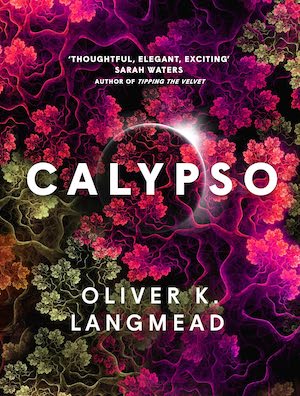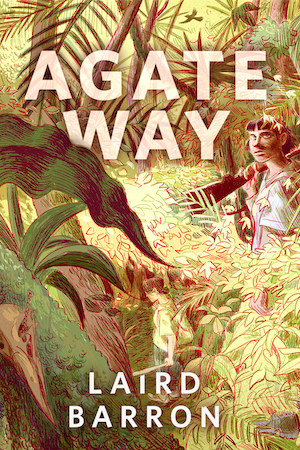Space is epic. Beyond epic, in fact—a human word representing a human concept could never describe the vast unknowability of our universe. Oliver K. Langmead’s new novel-in-verse, Calypso, takes luminous advantage of the way outer space lends itself to the grandiose language of myth and poetry. Told in four voices, each with their own meter, Langmead’s tale spans centuries and solar systems, with a vision of humanity at its center that suits the book’s decorated form.
The novel’s central character is an engineer named Rochelle, who has accepted a position on board the Calypso, a massive circular spaceship created to carry humanity to a brand new world. The ship’s designer and its mission’s visionary, Arthur Sigmund, invites Rochelle to join them because she disagrees with many of his ideas. He claims her dissenting opinion will challenge him, and ensure the best colony possible. Many other engineers, including the biologically enhanced Catherine, also join the project, going into centuries of stasis intended to last until the ship reaches the designated untouched planet. Yet when Rochelle awakens from her sarcophagus, the other vessels around her are long empty. Drifting through an echoing ship, she finds Catherine, whose skin sprouts mushrooms and vines as she tends the ship’s plant nursery. Together the two seek Sigmund, finding him on the planet’s barren surface, which will soon be terraformed to accommodate its new human population. Upon the trio’s return to the Calypso, a crew whose language has diverged from English meets them, celebrating them like triumphant monarchs. Yet Rochelle still gets no answers about where the other engineers are, or what caused the schism amongst the crew so obliquely hinted at by Sigmund.
This mystery propels much of the novel, when it is not overshadowed by the dizzying terraforming process. Langmead has shared that Milton’s Paradise Lost was a central inspiration for Calypso, and indeed the shaping of the planet reaches biblical heights. Swirling clouds of nanites adjust certain regions’ exposure to the sun, creating seasons, while chemical missiles create geological rifts that torrential storms turn into oceans. This celestial manipulation soon telescopes down to a primordial level in the book’s most triumphant sequence: Catherine’s arrival upon the planet’s surface and her sowing of life across the land. This section, Part Four, is an utter revelation. It is by turns viscerally gorgeous and disgusting, offering a genuine creation myth that folds together birth and death, sacrifice and survival. Many could read this part alone, and have an unforgettable experience.
Buy the Book


Calypso
Catherine’s narration of her task is so powerful that after it, the remainder of the book feels less like sweeping poetry and more like plot-driven science fiction. Rochelle finally gets an oral history that explains the absent engineers—and the lights of human habitation on a far-off moon. The reader at last learns what the much-vaunted differing opinions of Sigmund and Rochelle actually consist of. The Calypso prepares to send down the colonists, who turn out to be not quite the typical population sent on settler missions. There are meaty and affecting big ideas in the last three parts, certainly, but there are also a few plot holes and character weaknesses that weren’t previously apparent. For example, Rochelle never really articulates why she left her beloved children for this mission, though the novel often dwells on her grief and regret around that decision.
That said, epic poetry is rarely watertight in its plot, nor is it always concerned with the psychological subtleties of its characters. Langmead honors the form through his brilliant, evocative language and by engaging with vast philosophical questions. The verse obviously must have been painstakingly constructed, but it reads as effortless. The twelve syllable verse of Sigmund, reminiscent of the alexandrines used in classical French poetry, suits the character’s grandiose sense of self, while the loose pentameter of Rochelle, the most relatable character, flows comfortably. Catherine’s sections, verse arranged in waveforms on the page, are warmly immersive yet imposing, not unlike the character herself. In every meter, Langmead’s words are incredibly visual, building on each other to paint images unsettling and stunning alike. One of the more arresting recurrent views of the ship is the artificial greenspace created by the underfed, light-starved crew, full of plastic flowers, synthetic grass, and metal bulkheads painted like blue sky. Rochelle is never easy in these “parks”, a sensation that refracts further when she sees that this kind of design has made it onto the terraforming missiles:
The rocket closest to me is painted
To look like a forest, its cone a sky.
We will soon sow all these violent seeds,
And the surface of the new world will break.
The fact that expansive bombing is required to make this planet ready for human life is uncomfortable, sparking a familiar question that underlies Calypso: Just because we can, does that mean we should? This uncertainty kicks off a cascade of things for a reader to chew over: Is the drive behind Sigmund’s vision selfless, or the height of egoism? Is Rochelle naive for refusing enhancement out of faith in her God-given body, even if that enhancement is simply to protect her from cancer? Or is she principled? Should human beings sacrifice their futures and those of their children for the sake of Humanity as a species?
To elaborate further on these questions would involve spoilers, but even a few should make clear that Calypso participates in a long tradition of speculative fiction wrestling the metaphysical. There are even a few resonances with other sprawling intergalactic sagas, such as the “lords” who survive in ever-healing nanite baths paralleling the zeitgeisty Baron Harkonnen of Dune, or the clashing faiths of the Calypso’s crew evoking the specter of Gaius Baltar’s cult on Battlestar Galactica. Langmead’s genius lies in melding this sci-fi tradition with a much longer one of versified storytelling; he takes the weight of the future and transmits it through a style associated with the past, to grand effect. Let there be more epic space verse, please, and let it all be as successful as Calypso.
Calypso is published by Titan Books.










